Affiliate links on Android Authority may earn us a commission. Learn more.
System on a chip guide - Spring 2015
Published onFebruary 20, 2015

Many of this year’s flagship smartphones will soon be upon us and most of the industry’s big system on a chip manufacturers have already announced new designs to power this year’s handsets. Our latest system on a chip guide aims to help you pin down what you can expect from these new devices, or alternatively what SoCs you should look out for if you’re after certain features.
More 64-bit Snapdragons
Qualcomm has released its first high-end 64-bit SoC, the much talked about Snapdragon 810, and has also recently announced some impressive looking revisions to its mid and low tier chips. Just as with previous years, Qualcomm is likely to be powering a huge percentage of new mobile products this year.
Let’s start with the flagship 810. The move to 64-bit sees Qualcomm drop its custom Krait CPU cores in favor of ARM’s reference high performance Cortex-A57 and energy efficiency Cortex-A53. These are arranged in the familiar 4xA57 and 4xA53 big.LITTLE configuration, which is now the staple of flagship SoCs, as you will see throughout our list.
Although the basic components may sound familiar, the Snapdragon 810 also has a few unique features of its own. These include, dual channel 1555MHz LPDDR4 RAM memory, Qualcomm’s own optimized multi-core task scheduling, and the move to more energy efficient 20nm manufacturing. Qualcomm also has its 2xA57 + 4xA53 Snapdragon 808 listed on its website, but we haven’t heard anything about upcoming products.
| Snapdragon 810 | Snapdragon 808 | Snapdragon 805 | |
|---|---|---|---|
Core Count | Snapdragon 810 8 | Snapdragon 808 6 | Snapdragon 805 4 |
CPU | Snapdragon 810 4x Cortex-A57 + 4x Cortex-A53 (ARMv8-A) | Snapdragon 808 2x Cortex-A57 + 4x Cortex A53 (ARMv8-A) | Snapdragon 805 4x Krait 450 (ARMv7-A) |
Memory | Snapdragon 810 2x 1555MHz LPDDR4 (25.6GBps) | Snapdragon 808 2x 933MHz LPDDR3 (15GBps) | Snapdragon 805 2x 800MHz LPDDR3 (12.8GBps) |
GPU | Snapdragon 810 Adreno 430 | Snapdragon 808 Adreno 418 | Snapdragon 805 Adreno 420 |
Data | Snapdragon 810 Cat 9 LTE | Snapdragon 808 Cat 9 LTE | Snapdragon 805 Cat 4 LTE |
Process | Snapdragon 810 20nm | Snapdragon 808 20nm | Snapdragon 805 28nm |
Despite some industry reservations regarding the chip’s performance, extensive early benchmarks place the chip pretty much where you would expect. The common Cortex-A57 and A53 CPU setup closely matches what we have seen from Samsung’s similar chip, and Qualcomm’s new high-end Adreno 430 GPU again steps ahead of the competition.
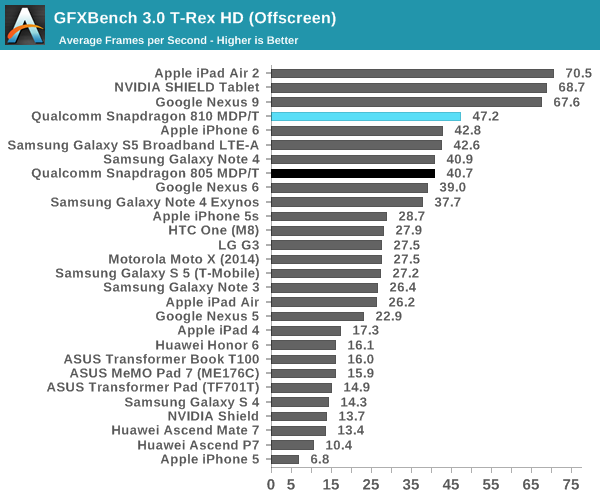
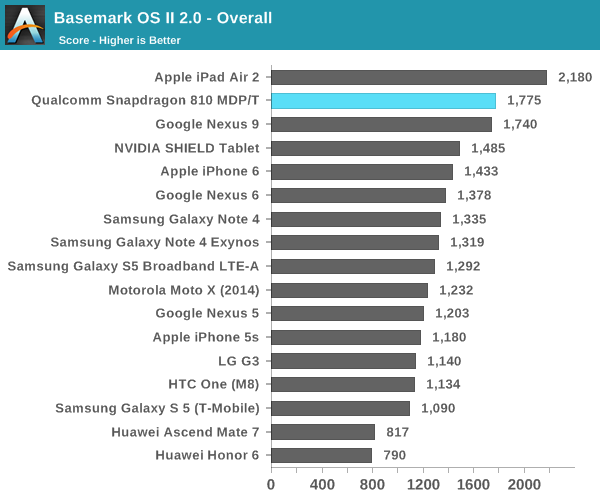
However, there are still a few question marks left hanging over the Snapdragon 810. Firstly, despite supporting LPDDR4 memory, benchmarking showed mixed results and no real performance edge over older memory designs. Secondly, the GPU benchmark results suggest that performance has been beefed up in some areas but not others, meaning that performance may not always exceed the Snapdragon 805’s Adreno 420. And smooth 4K performance is still a long way off.
Overall, the Snapdragon 810 looks to be a decent offering but only really serves to keep up with existing 64-bit SoCs. It isn’t going to be a far superior performer to other high-end SoCs already on the market.
Moving on, Qualcomm also recently announced four new 64-bit chips which will make up this year’s entries in the company’s mid-tier Snapdragon 600 and 400 ranges. The new Snapdragon 415 and 425 move the on up to an octa-core 64-bit Cortex-A53 configuration and will also feature faster LTE support and two ISPs. The eight Cortex-A53 and Adreno 405 setup will provide plenty of power for your day to day tasks, but will lack the raw grunt required for gaming and heavy duty tasks. Essentially, these chips are a direct replacement for Qualcomm’s Snapdragon 615.
| Snapdragon 620 | Snapdragon 618 | Snapdragon 425 | Snapdragon 415 | |
|---|---|---|---|---|
Core Count | Snapdragon 620 8 | Snapdragon 618 6 | Snapdragon 425 8 | Snapdragon 415 8 |
CPU | Snapdragon 620 4x 1.8GHz Cortex-A72 + 4x 1.2GHz Cortex A53 | Snapdragon 618 2x 1.8GHz Cortex-A72 + 4x 1.2GHz Cortex A53 | Snapdragon 425 8x 1.7GHz Cortex-A53 | Snapdragon 415 8x 1.4GHz Cortex-A53 |
Memory | Snapdragon 620 2x 933MHz LPDDR3 | Snapdragon 618 2x 933MHz LPDDR3 | Snapdragon 425 933MHz LPDDR3 | Snapdragon 415 667MHz LPDDR3 |
GPU | Snapdragon 620 unknown Adreno | Snapdragon 618 unknown Adreno | Snapdragon 425 Adreno 405 | Snapdragon 415 Adreno 405 |
Data | Snapdragon 620 Cat 7 LTE | Snapdragon 618 Cat 7 LTE | Snapdragon 425 Cat 7 LTE | Snapdragon 415 Cat 4 LTE |
Process | Snapdragon 620 28nm | Snapdragon 618 28nm | Snapdragon 425 28nm | Snapdragon 415 28nm |
More powerful mid-range handsets will likely turn to the Snapdragon 618 and 620, which feature four Cortex-A53s combined with either two or four of ARM’s latest Cortex-A72 CPU designs respectively. Despite the larger numbers, the A72 is not designed to offer substantially more performance than the A57, and actual performance should be rather comparable. Instead, the design looks to be more energy efficient. However, these SoCs will be built on a 28nm manufacturing process to bring them to market quicker. Therefore, performance and energy savings won’t quite live up to the peak numbers offered by ARM when it announced the 16nm design.
We can expect to see the Snapdragon 415 make an appearance within the next few months, while the 425, 618 and 620 won’t arrive in consumer products until much later in the year.
Samsung 14nm Exynos 7 Octa
Samsung was one of the first mobile SoC manufacturers to adopt ARM’s increasingly prevalent big.LITTLE multi-core architecture and the company has made big strides to implement improved heterogeneous multicore processing, thanks to global task scheduling, since then. The company was also one of the first to put out an ARMv8-A chip using the A57 and A53 CPU combo, which can be found inside the Exynos 5433 powered Galaxy Note 4 and Note Edge.
A little while back, Samsung introduced its Exynos 7 Octa series. The company has been keeping the specifics of its Exynos 7 series under wraps, but the Exynos 7410, which is yet to debut in any products by name, appears to keep exactly the same configuration as the Exynos 5433. Samsung’s current setup pairs the CPU with ARM’s Mali-T760 MP6 GPU and LPDDR3 memory, and is also designed for a 20nm process.
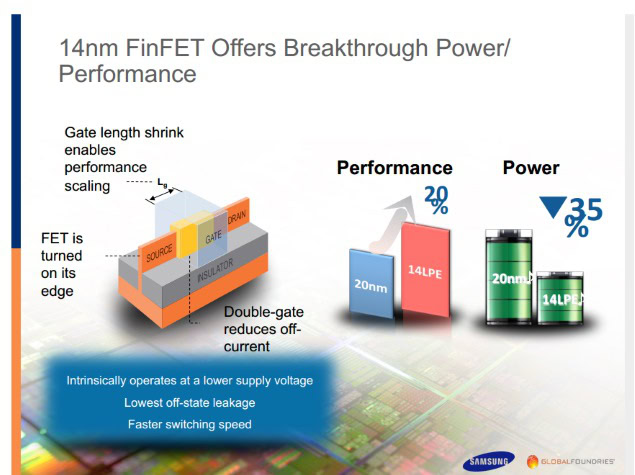
More recently, Samsung announced a 14nm FinFET Exynos 7, expected to be named the Exynos 7420. Exact details of this chip have not been given either. It is highly likely that the chip will feature an almost identical makeup to Samsung’s current chip design, but will benefit from the increased energy efficiency of its 14nm design. Part for part, Samsung’s Exynos 7 will compete closely with Qualcomm’s Snapdragon 810, but the move to 14nm could give the chip a performance and/or battery life advantage.
Rumors suggest that the Samsung Galaxy S6 will be powered exclusively by Samsung’s own chip this time around, but no-one knows for sure if this will be a 20nm or 14nm Exynos 7 Octa SoC. It likely all depends on how many small chips Samsung can produce in time for the handset’s launch.
Nvidia’s GPU powerhouse Tegra X1
Following a brief experiment with its own Denver CPU design, Nvidia is also jumping over to the ARMv8-A architecture with its latest 20nm Tegra X1 SoC. Again, we’re looking at a 4xA57 + 4xA53 CPU layout, combined with NVIDIA’s latest Maxwell based GPU. While CPU performance is comparable to other products on the market, NVIDIA claims to have doubled the GPU performance and halved the Tegra X1’s power requirements compared with the Tegra K1.
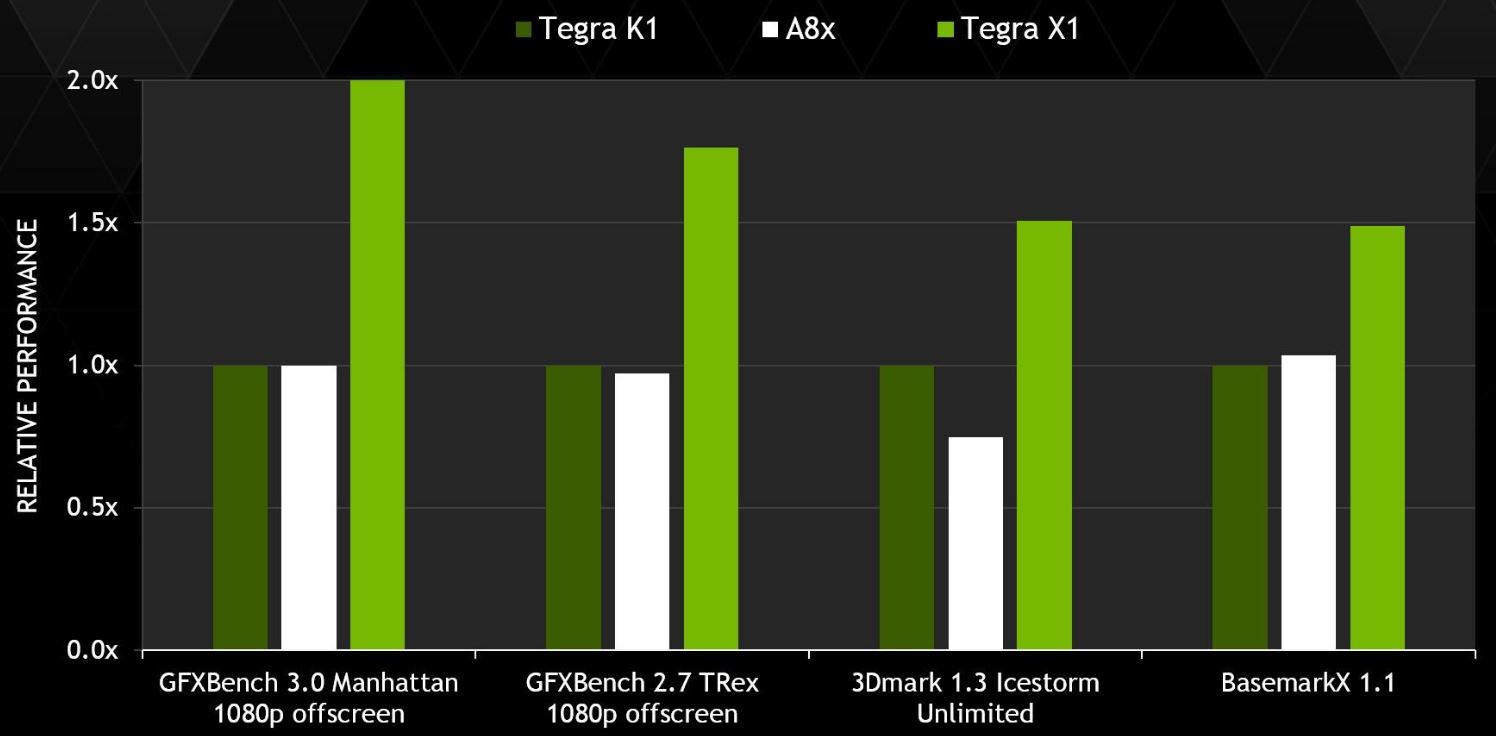
The graphics giant also has a few additional tweaks to help make the Tegra X1 stand out above the competition. NVIDIA has opted for its own custom interconnect, rather than ARM’s CCI-400, and cluster migration, rather than global task scheduling, which the company claims allows for more efficient process management across all eight cores. Cache coherence reduces the power/performance penalties usually associated with cluster migration, which could help boost CPU performance in certain scenarios.
Additionally, NVIDIA has improved its in-house texture compression, supports eMMC 5.1 memory, and has implemented a 64-bit wide LPDDR4 memory interface to offer improved memory speeds. Although, we haven’t seen any benchmarks to judge the performance yet.
NVIDIA is also making a big effort to rival Qualcomm’s media feature set this time. The Tegra X1 features 60fps 4K H.265, H.264, VP9 and VP8 video encode and decode and dual ISPs, which support 4096 focus points, 100 MP sensors and up to 6 camera inputs.
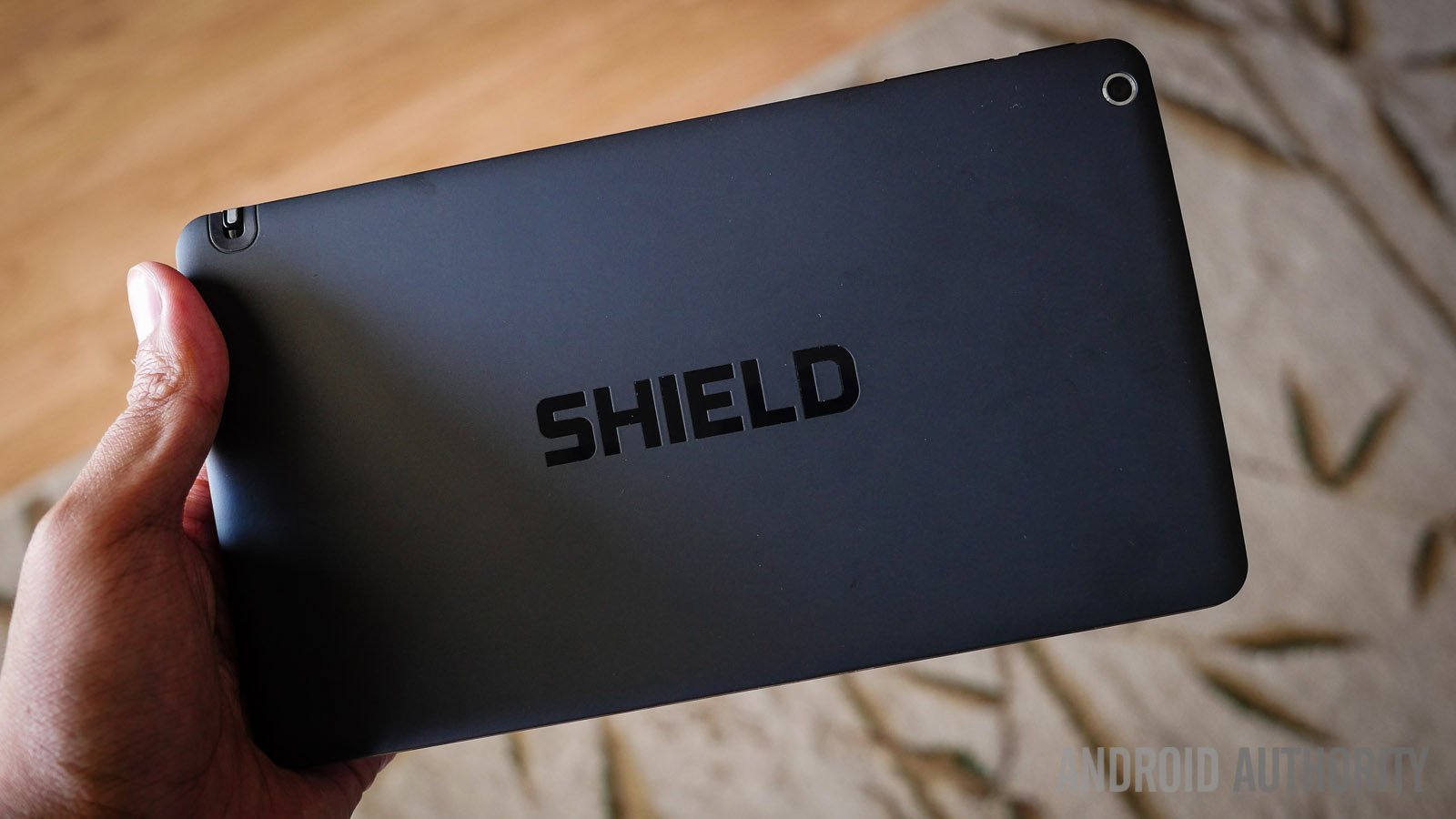
Like its predecessors, the Tegra X1 is a media and gaming centric SoC at its core, and it likely destined for high performance tablets. Its impressive GPU architecture seems like the benchmark to beat in 2015, and could be making an appearance in some upcoming NVIDIA gaming devices.
MediaTek
Media has not announced any new SoCs since last year, but already has a rather extensive range of 64-bit chips available for developers to use. We can almost certainly expect to see a large number of mid-tier smartphones powered by these chips this year.
The MT6752 and MT6795 are the company’s leading 64-bit octo-core SoCs. The former is built from eight Cortex-A53s, much like Qualcomm’s new 400 series SoCs, but features an ARM Mali-T760 GPU. However, this is only the MP2 version and doesn’t pack as much power as Samsung’s implementation. The MT6795 is a high-end 4xA57 + 4xA53 design, backed up with a mid-range PowerVR G6200 GPU.
| MT6795 | MT6752 | MT6735 | MT6732 | |
|---|---|---|---|---|
Core Count | MT6795 8 | MT6752 8 | MT6735 4 | MT6732 4 |
CPU | MT6795 4x 2.2GHz Cortex-A57 + 4x 1.7GHz Cortex A53 | MT6752 8x 1.7GHz Cortex-A53 | MT6735 4x 1.5GHz Cortex-A53 | MT6732 4x 1.5GHz Cortex-A53 |
Memory | MT6795 2x 933MHz LPDDR3 (14.9 GB/sec) | MT6752 1x 800MHz LPDDR3 (6.4 GB/sec) | MT6735 1x 800MHz LPDDR3 (6.4 GB/sec) | MT6732 1x 800MHz LPDDR3 (6.4 GB/sec) |
GPU | MT6795 PowerVR G6200 | MT6752 Mali-T760 MP2 | MT6735 Mali-T720 MP4 | MT6732 Mali-T760 MP2 |
Data | MT6795 Cat 4 LTE | MT6752 Cat 4 LTE | MT6735 Cat 4 LTE | MT6732 Cat 4 LTE |
Process | MT6795 28nm | MT6752 28nm | MT6735 28nm | MT6732 28nm |
This year, MediaTek has a new MT6735 on its way, which should appear in Q2 2015. The chip is a low-end, quad-core Cortex-A53 design paired up with a Mali-T720 MP4 GPU, which is definitely limited to the budget end of the market.
MediaTek’s big drive has been to compete with Qualcomm on radio technology and all of its ARMv8-A based chips feature integrated Category 4 LTE modems, which allow for peak download speeds of 150 Mbit/sand upload speeds of 50 Mbit/s.
This year MediaTek powered devices will be very capable in the CPU department, but are lagging behind premium-tier SoCs when it comes to GPU and memory technology.
Intel competes on price
Intel is still a minor player in the smartphone market, but 2015 is the year that the company’s major mobile plans will finally hit the market. Intel’s 22nm Merrifield Z3560 and Z3580 SoCs have found a home in the new ASUS Zenfone 2, and Intel’s modem integrated SoFIA chips are also scheduled to appear in H1 2015.
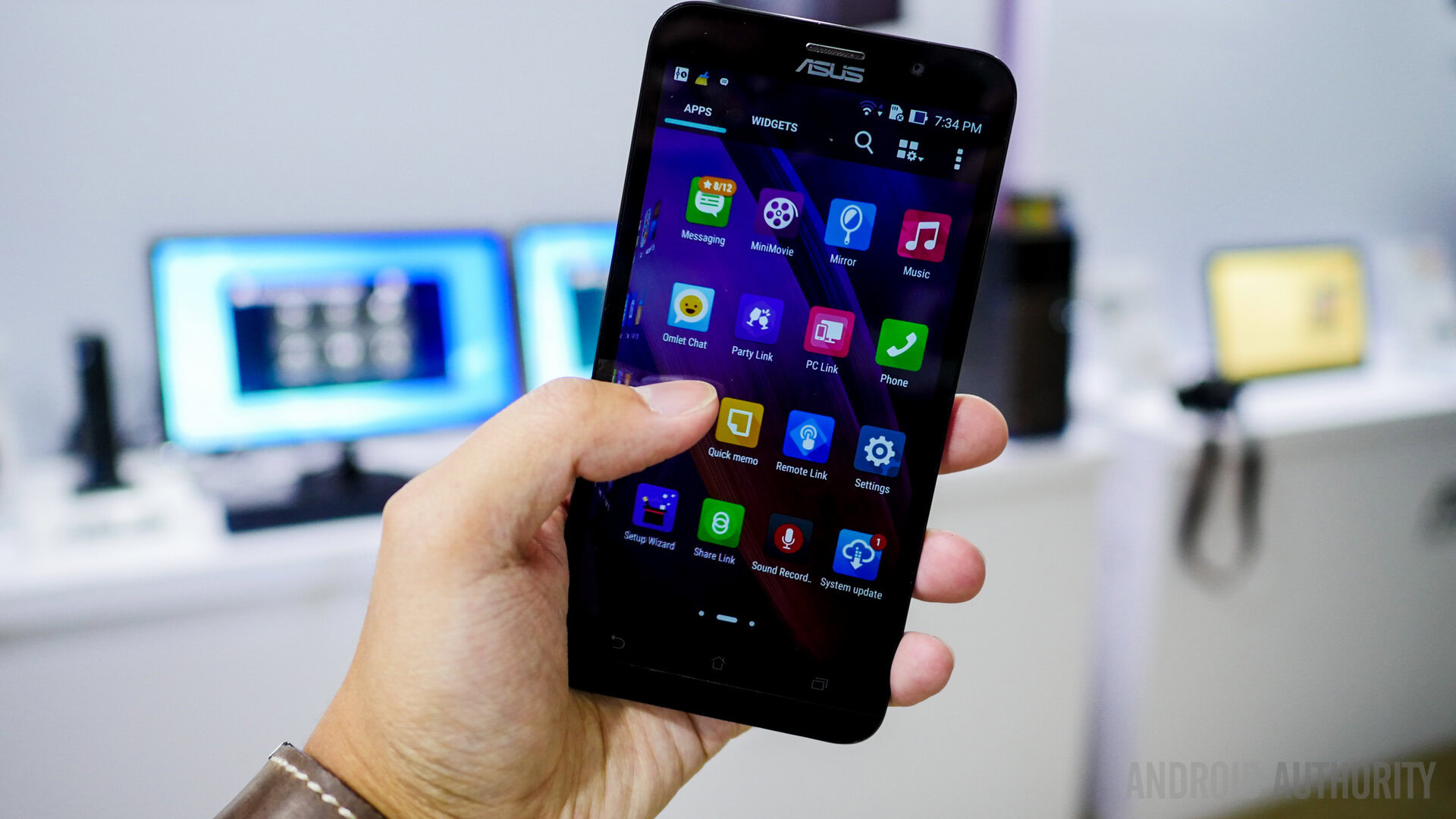
As well as finally bringing integrated HSPA+ and Category 4 LTE solutions to rival the competition, the SoFIA 3G and SoFIA LTE will also be adopting GPUs from ARM’s Mali range. The 3G SoFIA chip will feature a 22nm, 1.2GHz Intel Atom Z5210RK and Mali 450 MP4 clocked at 600 MHz.
The SoFIA LTE chip, which is also scheduled for a H1 release, will be built on Intel’s smaller 14nm process (Airmont CPU). The Atom Z5220’s CPU will come clocked at 1.4GHz and will be accompanied by a low-end Mali T720 MP2. The Cat 4 LTE functionality is taken from Intels’ XG726 modem. Both of these chips are clearly targeted at the mid to lower end of the market, but could offer some competition to MediaTek’s low-cost processors.
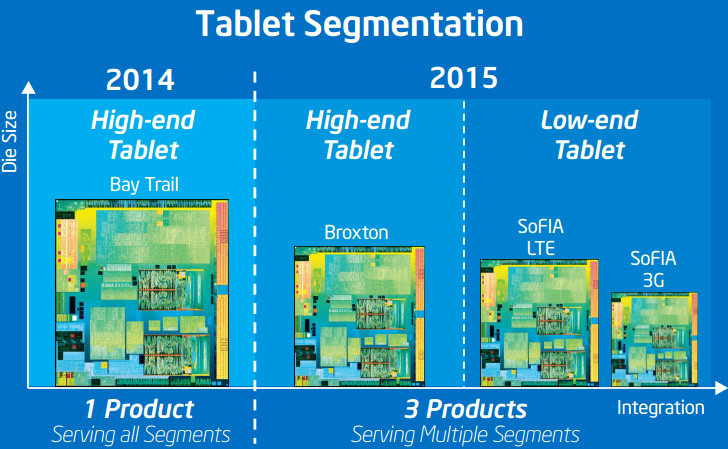
For tablets, Intel’s 14nm Cherry Trail SoCs have already begun rolling off the production line. With low-cost smartphone markets showing the greatest growth recently, Intel may have finally found a way into the smartphone market with SoFIA and reasonably priced partners, like ASUS. We’ll have to see if the company can capitalize on this opportunity.
Final thoughts
Overall, we aren’t looking at a massive jump in SoC CPU performance this year and the gap between low and high-end products is closing in this regard. However, the race to smaller manufacturing processes and more efficient big.LITTLE CPU designs could see a regeneration in battery longevity this year, which is an equally pleasing prospect. The demand for higher resolution display is being met with slightly more powerful GPU components, but no-one, apart from possibly NVIDIA, looks capable of sailing through the 2K barrier without noticeable performance impacts just yet. Fortunately, ARM and Qualcomm already have next-gen GPU products in the works, but that’s looking a little too far into the future.